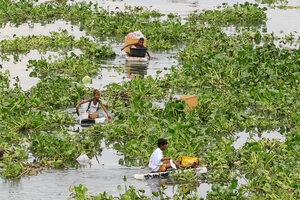Duterte signs Paris agreement. Why now?
Both Filipinos and foreign observers say that President Duterte, who has spurred controversy with his war on drugs, views climate change as a top national priority.

Filipino boys wade through a polluted river using makeshift rafts made of styrofoam to collect reusable items at a Manila bay in Baseco, Tondo city, metro Manila, Philippines, on August 1, 2016. President Duterte has signed to Paris Agreement in efforts to cut the nations greenhouse gases.
Romeo Ranoco/Reuters
Philippine President Rodrigo Duterte has signed the Paris Agreement on Climate Change, and sent it to the country’s Senate, which is expected to ratify it.
Under the agreement, Manila aims to reduce its carbon emissions by 70 percent by 2030 – an amount open to revision – and will receive assistance from the United Nation’s Green Climate Fund to do so. Duterte's commitment comes more than 10 months after the agreement was signed by more than a hundred countries at the United Nations headquarters in New York.
Since taking office last June, Mr. Duterte has drawn increasing criticism from other international leaders for his actions in launching a bloody war on drugs. But both Filipinos and outside observers say that he sees climate change as a top national priority.
“Climate change is so much part of his agenda,” the Philippines’ Climate Change Commission Vice Chairperson Secretary Vernice Victorio told The Rappler on Wednesday. “It’s in the Philippine Development Plan, it’s in his agenda. It’s everywhere. So don’t worry, [for] those who think he’s not into climate change.”
The risks of climate change are real for this vast island nation. Last year, the risk-analysis firm Verisk Maplecroft ranked it 13th out of 186 countries on its Climate-Change Vulnerability Index.
Observers worry that, as global temperatures rise, natural disasters like 2013’s Typhoon Haiyan, which killed more than 6,300 Filipinos, left more than 4.37 million homeless, and caused more than $2 billion in damages, could grow more frequent.
The NGO EcoWatch, citing a Philippine government study, warned that:
[A] destructive typhoon season costs the nation two percent of its gross domestic product. It costs another two percent to rebuild the infrastructure lost, putting the Philippines at least four percent in the hole each year from tropical storms. And when you’re a nation aspiring to grow and create better lives for your citizens, this regular hit to the economy is the last thing you can afford.
Since Haiyan, the UN Office for Disaster Preparedness and Risk Reduction has praised the Philippines for “improved disaster preparedness.” And, at the 2015 Paris Accords, the Philippines signaled its commitment to reversing the trends behind more powerful storms, submitting a proposal to reduce its carbon emissions by 70 percent by 2030.
As a developing country, the Philippines would have received international assistance to meet that goal – at the time of the agreements, France offered it 50 million euros in climate aid.
But the prospect of cutting carbon emissions by 70 percent struck the Duterte administration, which, despite its emphasis on climate change, also sees coal as an important cheap power source, as too drastic.
But after receiving assurances that the target could be revised, the president warmed to the treaty. “When it was clarified that the 70% can be changed, that was also the big – it allowed them, it allowed him to finally say ‘yes’ last year,” Ms. Victorio told The Rappler.
It’s too soon to tell what new reductions target, if any, the administration would seek, and if it would still prove significant to the fight against climate change.
But the country’s science secretary, Fortunato dela Peña, sees the 70 percent target as achievable.
“Whatever difficulties we may encounter,” he told the Philippine Star, “we are bound to extend our support to that so I think it is doable.”
This report contains material from Reuters.

